Fe/TaC Coatings Produced on 145Cr6 Steel by Laser Alloying—Manufacturing Parameters and Material Characterization
Abstract
:1. Introduction
2. Materials and Methods of Research
2.1. Materials
2.2. Precoat Production and Laser Processing Parameters
2.3. Microstructure Investigation
2.4. Chemical and Phase Composition Examination
2.5. Microhardness Measurements
2.6. Wear Resistance Tests
3. Results and Discussion
3.1. Macroscopic Observation and Microstructure Analysis
3.2. Chemical and Phase Composition Results
3.3. Microhardness Observations
3.4. Wear Resistance
4. Conclusions
- It is possible to produce full-size composite coatings in which the reinforcing phase is TaC and the matrix is iron from the steel substrate.
- An increase in laser beam power reduces the number of TaC particles, simultaneously affecting the composite character of the coatings. In the microstructure, the eutectic of tantalum is formed as a mesh, which creates a reinforcing phase.
- The use of a low laser beam power results in a higher tantalum content in the Fe/TaC coating. On the other hand, an increase in power contributes to the reduction of its share and thus to a reduction in microhardness.
- In terms of wear resistance, it is the most favorable to produce an Fe/TaC coating using a laser beam power of 500 W and a 90 µm precoat.
Author Contributions
Funding
Institutional Review Board Statement
Informed Consent Statement
Data Availability Statement
Conflicts of Interest
References
- Lawrence, J.R.; Waugh, D. Laser surface engineering: Processes and applications. In Woodhead Publishing Series in Metals and Surface Engineering Book, 1st ed.; Kindle Edition: Chester, UK, 2014. [Google Scholar]
- Dowden, J.; Schulz, W. The Theory of Laser Materials Processing: Heat and Mass Transfer in Modern Technology, 2nd ed.; Springer Series in Materials Science; Springer Dordrecht: Bristol, UK, 2017; ISBN-13: 978-3319567105. [Google Scholar]
- Fan, L.I.; Dong, Y.; Chen, H.; Dong, L.; Yin, Y. Wear Properties of Plasma Transferred Arc Fe-based Coatings Reinforced by Spherical WC Particles. J. Wuhan Univ. Technol.-Mater. Sci. Edit. 2019, 34, 433–439. [Google Scholar] [CrossRef]
- Kukliński, M.; Bartkowska, A.; Przestacki, D. Microstructure and selected properties of Monel 400 alloy after laser heat treatment and laser boriding using diode laser. Int. J. Adv. Manuf. Technol. 2018, 98, 3005–3017. [Google Scholar] [CrossRef] [Green Version]
- Dobrzański, L.A.; Labisz, K.; Piec, M.; Klimpel, A. Modelling of surface layer of the 31CrMoV12-18 tool steel using HPDL laser for alloying with TiC powder. J. Achiev. Mater. Manuf. Eng. 2007, 24, 27–34. [Google Scholar]
- Abbas, G.; West, D.R.F. Laser surface cladding of Stellite and Stellite-SiC composite deposits for enhanced hardness and wear. Wear 1991, 143, 353–363. [Google Scholar] [CrossRef]
- Chao, M.-J.; Niu, X.; Yuan, B.; Liang, E.-J.; Wang, D.-S. Preparation and characterization of in situ synthesized B4C particulate reinforced nickel composite coatings by laser cladding. Surf. Coat. Technol. 2006, 201, 1102–1108. [Google Scholar] [CrossRef]
- Bartkowski, D.; Bartkowska, A. Wear resistance in the soil of Stellite-6/WC coatings produced using laser cladding method. Int. J. Refract. Met. Hard Mater. 2017, 64, 20–26. [Google Scholar] [CrossRef]
- Ertugrul, O.; Enrici, T.M.; Paydas, H.; Saggionetto, E.; Boschini, F.; Mertens, A. Laser cladding of TiC reinforced 316L stainless steel composites: Feedstock powder preparation and microstructural evaluation. Powder Technol. 2020, 375, 384–396. [Google Scholar] [CrossRef]
- Lv, X.; Zhan, Z.; Cao, H.; Guo, C. Microstructure and properties of the laser cladded in-situ ZrB2-ZrC/Cu composite coatings on copper substrate. Surf. Coat. Technol. 2020, 396, 125937. [Google Scholar] [CrossRef]
- Bartkowski, D.; Bartkowska, A.; Jurči, P. Laser cladding process of Fe/WC metal matrix composite coatings on low carbon steel using Yb: YAG disk laser. Opt. Laser Technol. 2021, 136, 106784. [Google Scholar] [CrossRef]
- Davoren, B.; Sacks, N.; ·Theron, M. Microstructure characterization of WC-9.2wt%Monel 400 fabricated using laser engineered net shaping. Prog. Addit. Manuf. 2021, 6, 431–443. [Google Scholar] [CrossRef]
- Yilbas, B.S.; Arif, A.F.M.; Karatas, C.; Ahsan, M. Cemented carbide cutting tool: Laser processing and thermal stress analysis. Appl. Surf. Sci. 2007, 253, 5544–5552. [Google Scholar] [CrossRef]
- Teghil, R.; D’Alessio, L.; De Maria, G.; Ferro, D. Pulsed-laser deposition and characterization of TaC films. Appl. Surf. Sci. 1995, 86, 190–195. [Google Scholar] [CrossRef]
- Karatas, C.; Yilbas, B.S.; Aleem, A.; Ahsan, M. Laser treatment of cemented carbide cutting tool. J. Mater. Process. Technol. 2007, 183, 234–240. [Google Scholar] [CrossRef]
- Ferro, D.; Rau, J.V.; Rossi Albertini, V.; Generosi, A.; Teghil, R.; Barinov, S.M. Pulsed laser deposited hard TiC, ZrC, HfC and TaC films on titanium: Hardness and an energy-dispersive X-ray diffraction study. Surf. Coat. Technol. 2008, 202, 1455–1461. [Google Scholar] [CrossRef]
- Chao, M.; Wang, W.; Liang, E.; Ouyang, D. Microstructure and wear resistance of TaC reinforced Ni-based coating by laser cladding. Surf. Coat. Technol. 2008, 202, 1918–1922. [Google Scholar] [CrossRef]
- Yu, T.; Deng, Q.; Dong, G.; Yang, J. Effects of Ta on microstructure and microhardness of Ni based laser clad coating. Appl. Surf. Sci. 2011, 257, 5098–5103. [Google Scholar] [CrossRef]
- Li, M.Y.; Chao, M.J.; Liang, E.J.; Li, D.C.; Yu, J.M.; Zhang, J.J. Laser synthesised TaC for improving copper tribological property. Surf. Eng. 2013, 29, 616–6219. [Google Scholar] [CrossRef]
- Yu, T.; Deng, Q.L.; Zheng, J.F.; Dong, G.; Yang, J.G. Microstructure and wear behaviour of laser clad NiCrBSi+Ta composite coating. Surf. Eng. 2012, 28, 357–363. [Google Scholar] [CrossRef]
- Hu, D.; Liu, Y.; Chen, H.; Wang, M.; Liu, J. Microstructure and properties of in-situ synthesized Ni3Ta-TaC reinforced Ni-based coatings by laser cladding. Surf. Coat. Technol. 2021, 405, 126599. [Google Scholar] [CrossRef]
- Liu, Y.; Ding, T.; Lv, H.; Hu, D.; Zhang, Y.; Chen, H.; Chen, Y.; She, J. Microstructure and properties of Ta-reinforced cobalt based composite coatings processed by direct laser deposition. Surf. Coat. Technol. 2022, 447, 128874. [Google Scholar] [CrossRef]
- Huang, X.; Yu, J.; Jiang, J.; Lian, G.; Chen, C.; Zhou, M.; Xu, W.; Hu, X. Effect of Ta Content on the Microstructure and Properties of Laser Cladding Ni60A/WC Composite Coatings. JOM 2023, 75, 97–108. [Google Scholar] [CrossRef]
- Murzakov, M.A.; Petrovskiy, V.N.; Polski, V.I.; Mironov, V.D.; Prokopova, N.M.; Tret’yakov, E.V. Influence of additions of nanoparticles TaC on a microstructure laser cladding. J. Phys. Conf. Ser. 2015, 594, 012032. [Google Scholar] [CrossRef]
- Lv, Y.H.; Li, J.; Tao, Y.F.; Hu, L.F. High-temperature wear and oxidation behaviors of TiNi/Ti2Ni matrix composite coatings with TaC addition prepared on Ti6Al4V by laser cladding. Appl. Surf. Sci. 2017, 402, 478–494. [Google Scholar] [CrossRef]
- Yu, T.; Chen, J.; Wen, J.; Deng, Q. High temperature phase stability and wear behavior of laser clad Ta reinforced NiCrBSi coating. Appl. Surf. Sci. 2021, 547, 149171. [Google Scholar] [CrossRef]
- Li, Z.; Yan, H.; Zhang, P.; Guo, J.; Yu, Z.; Ringsberg, J.W. Improving surface resistance to wear and corrosion of nickel-aluminum bronze by laser-clad TaC/Co-based alloy composite coatings. Surf. Coat. Technol. 2021, 405, 126592. [Google Scholar] [CrossRef]
- Bartkowski, D. Manufacturing Technology and Properties of Fe/TaC Metal Matrix Composite Coatings Produced on Medium Carbon Steel Using Laser Processing—Preliminary Study on the Single Laser Tracks. Materials 2021, 14, 5367. [Google Scholar] [CrossRef]

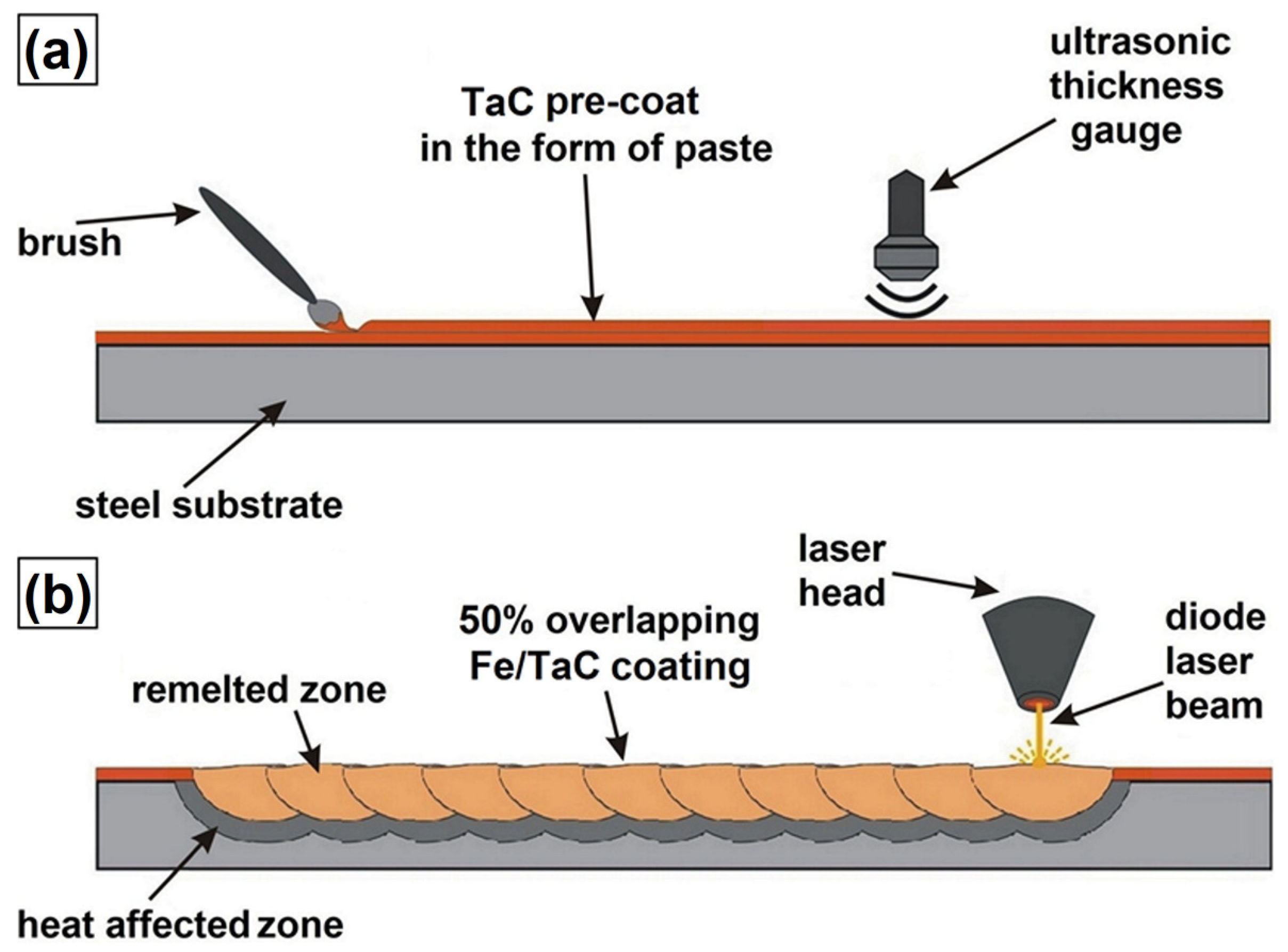
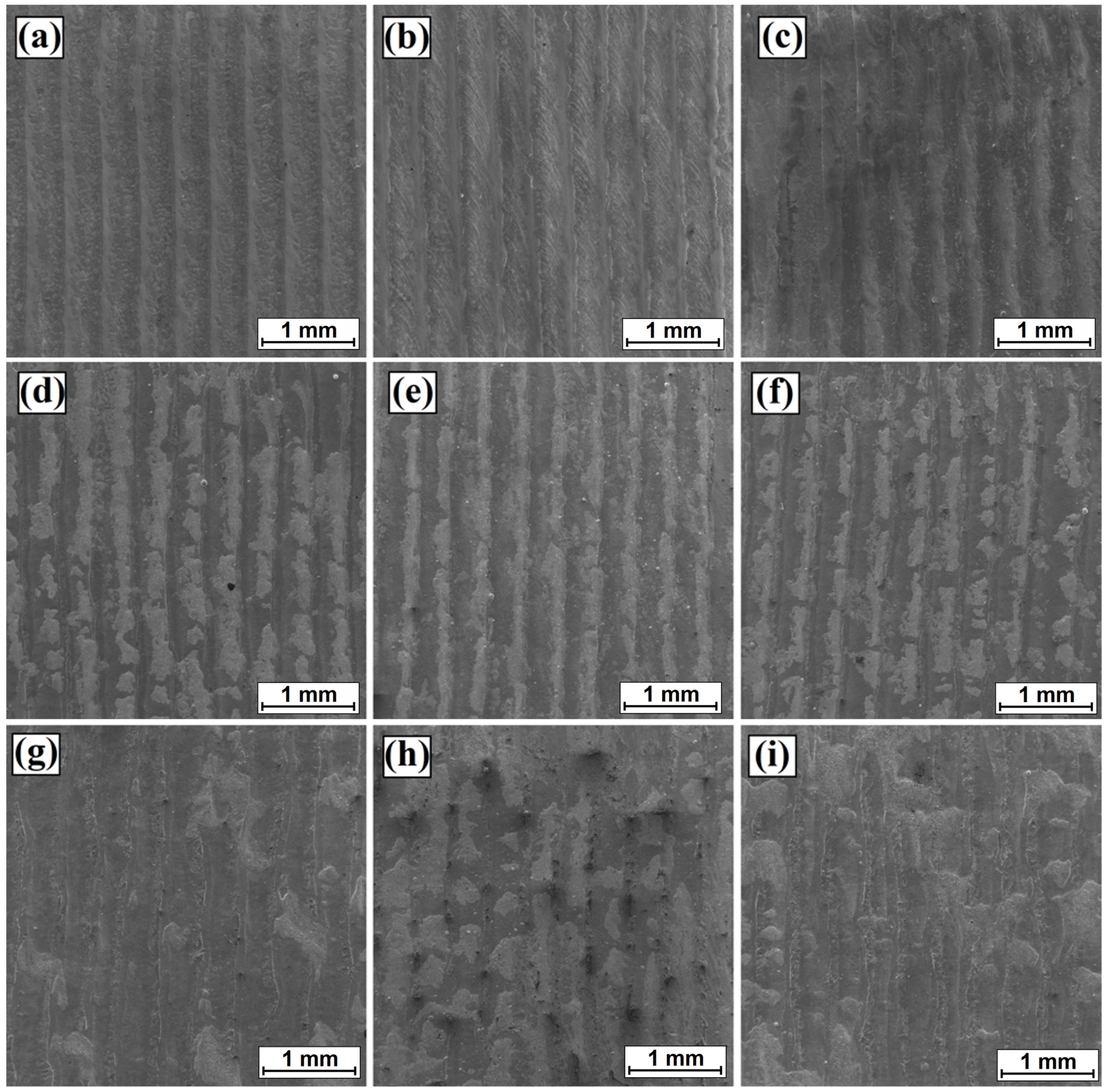


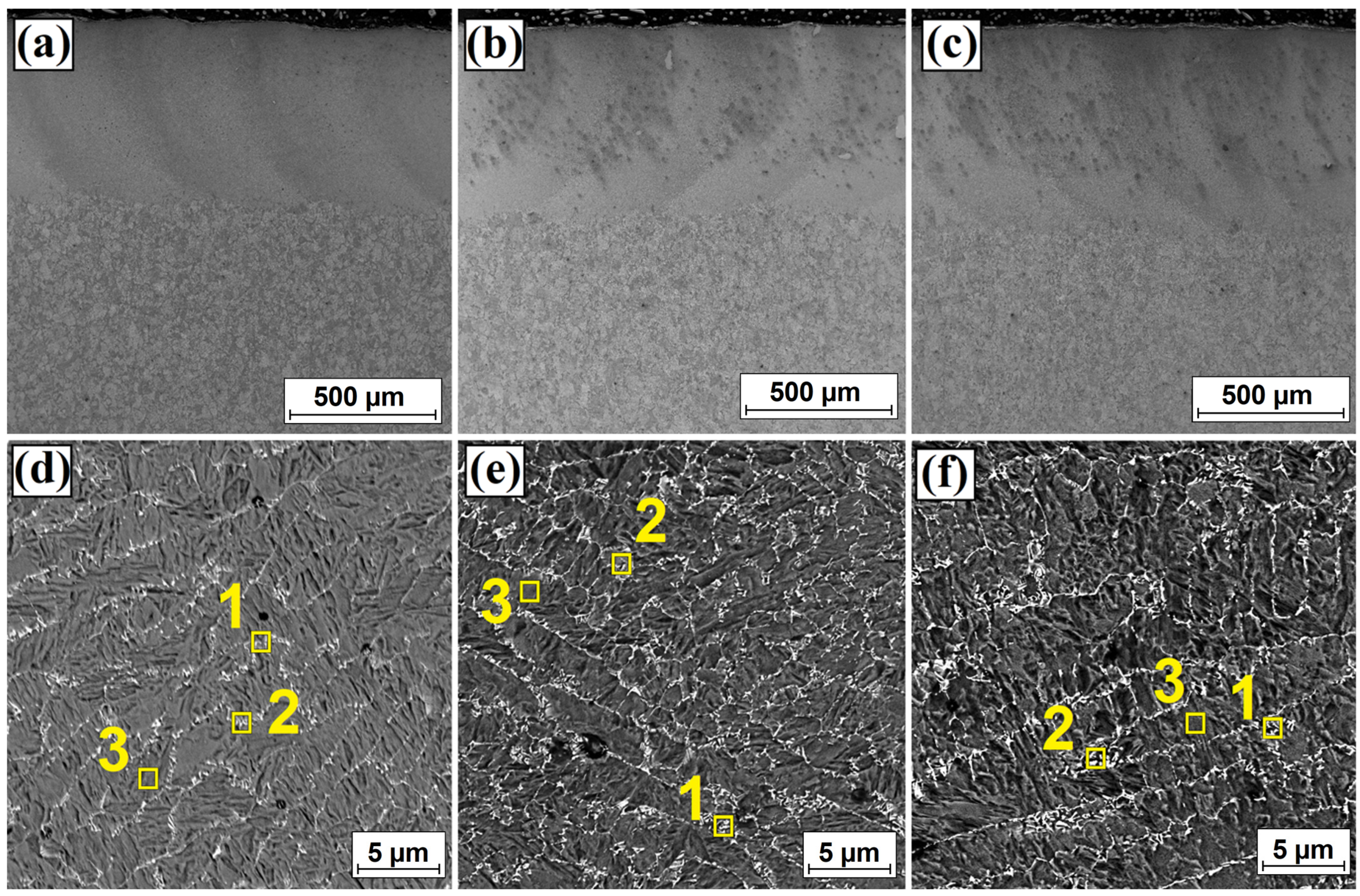
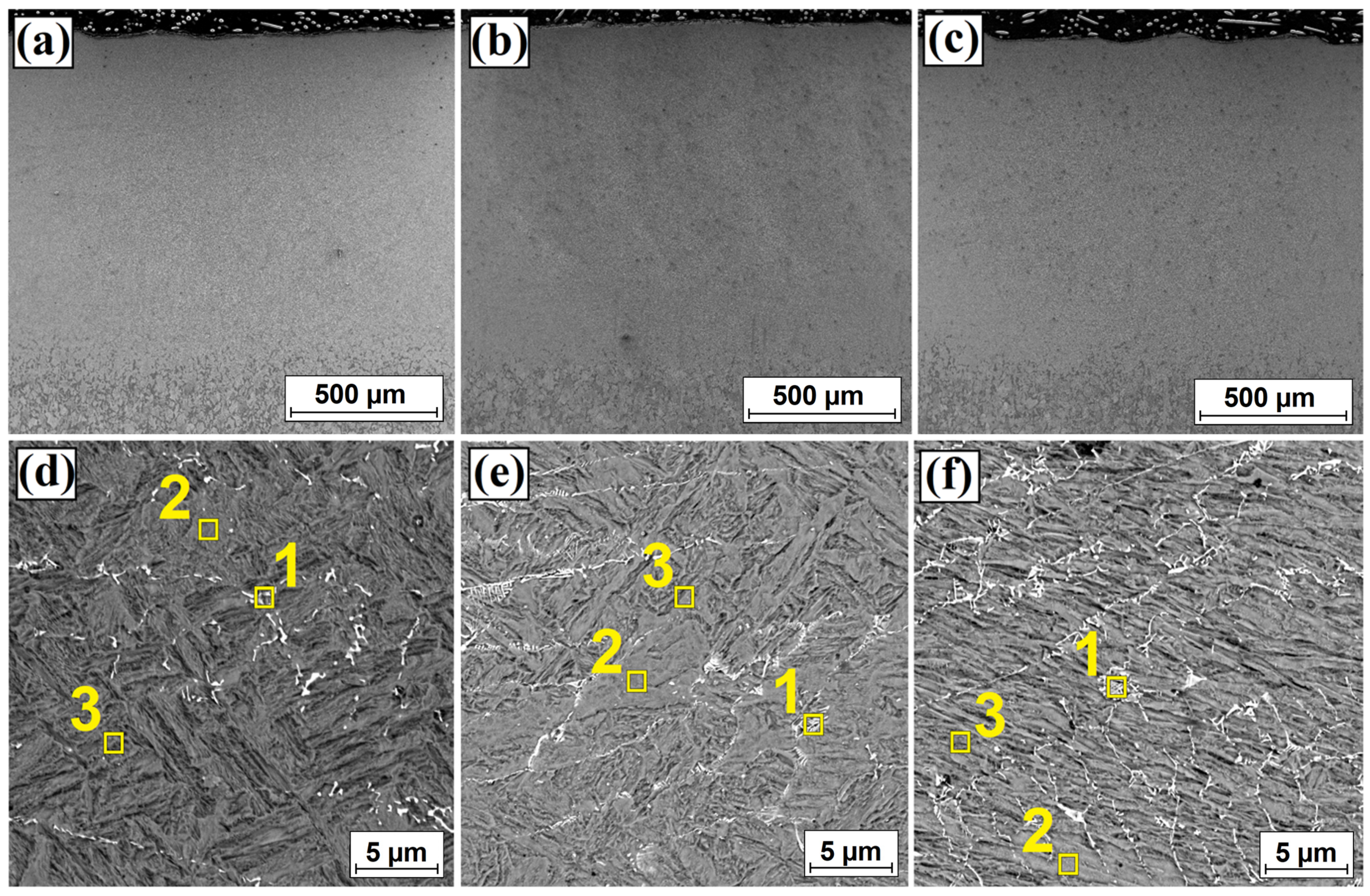
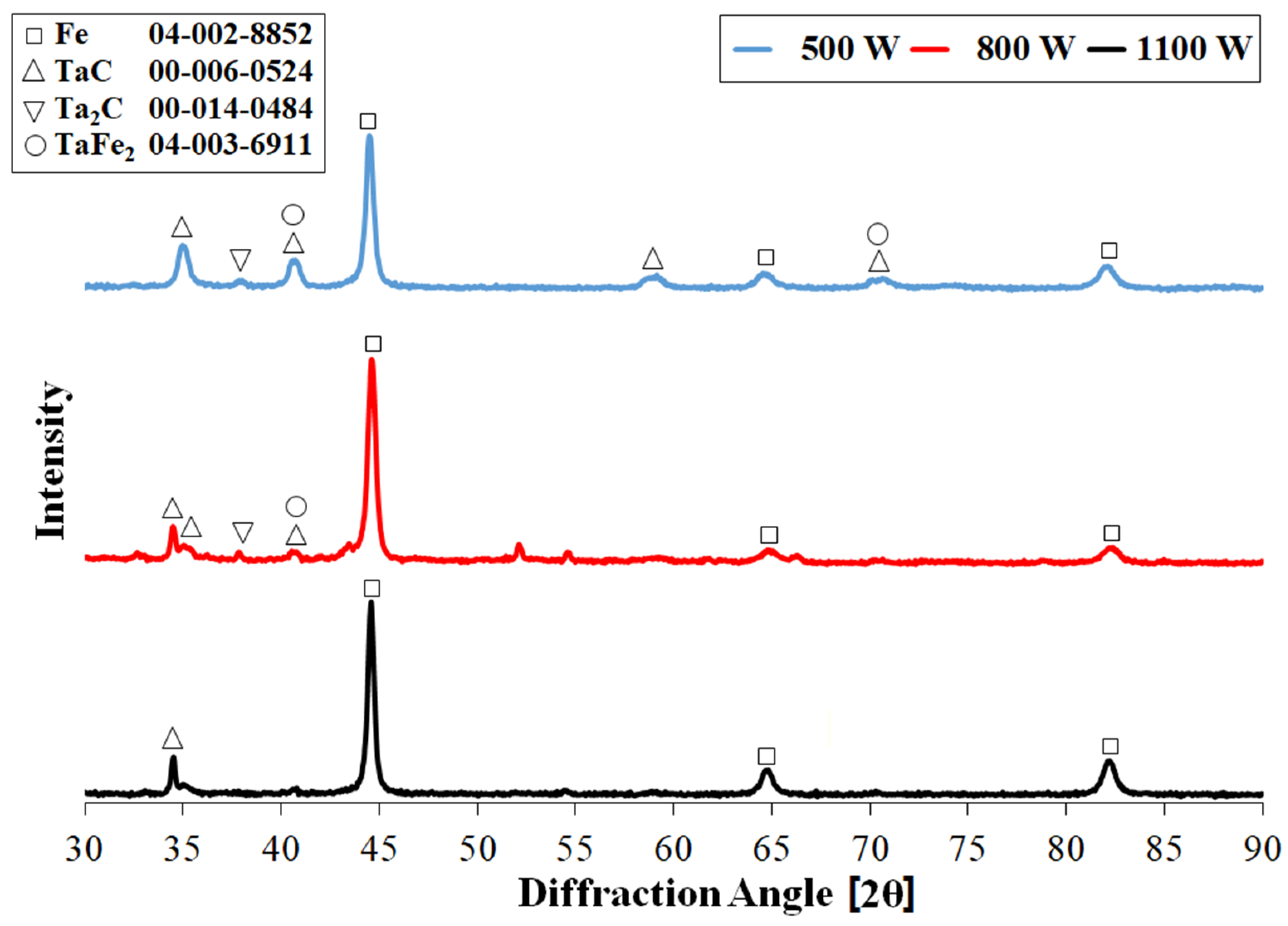
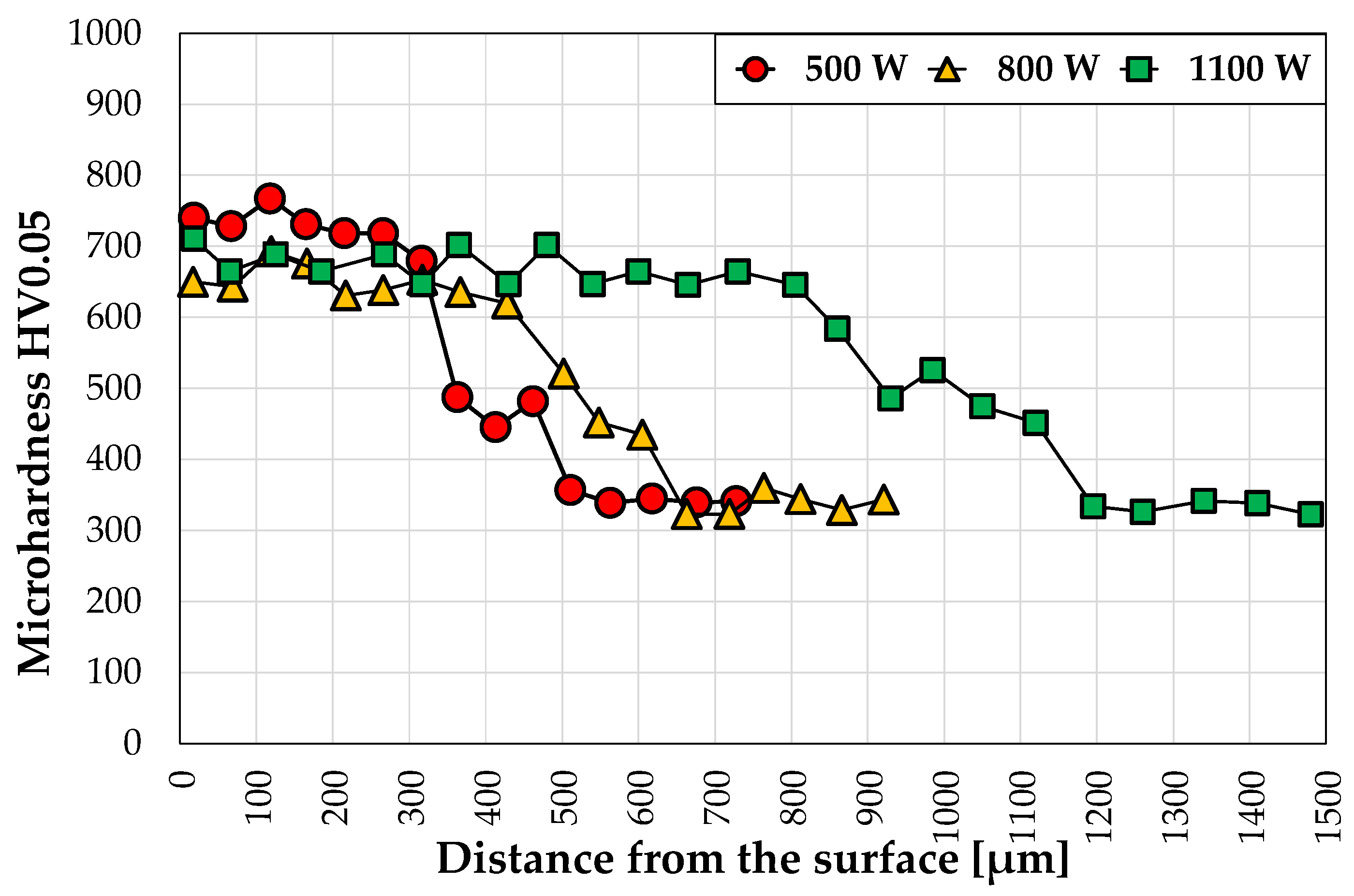
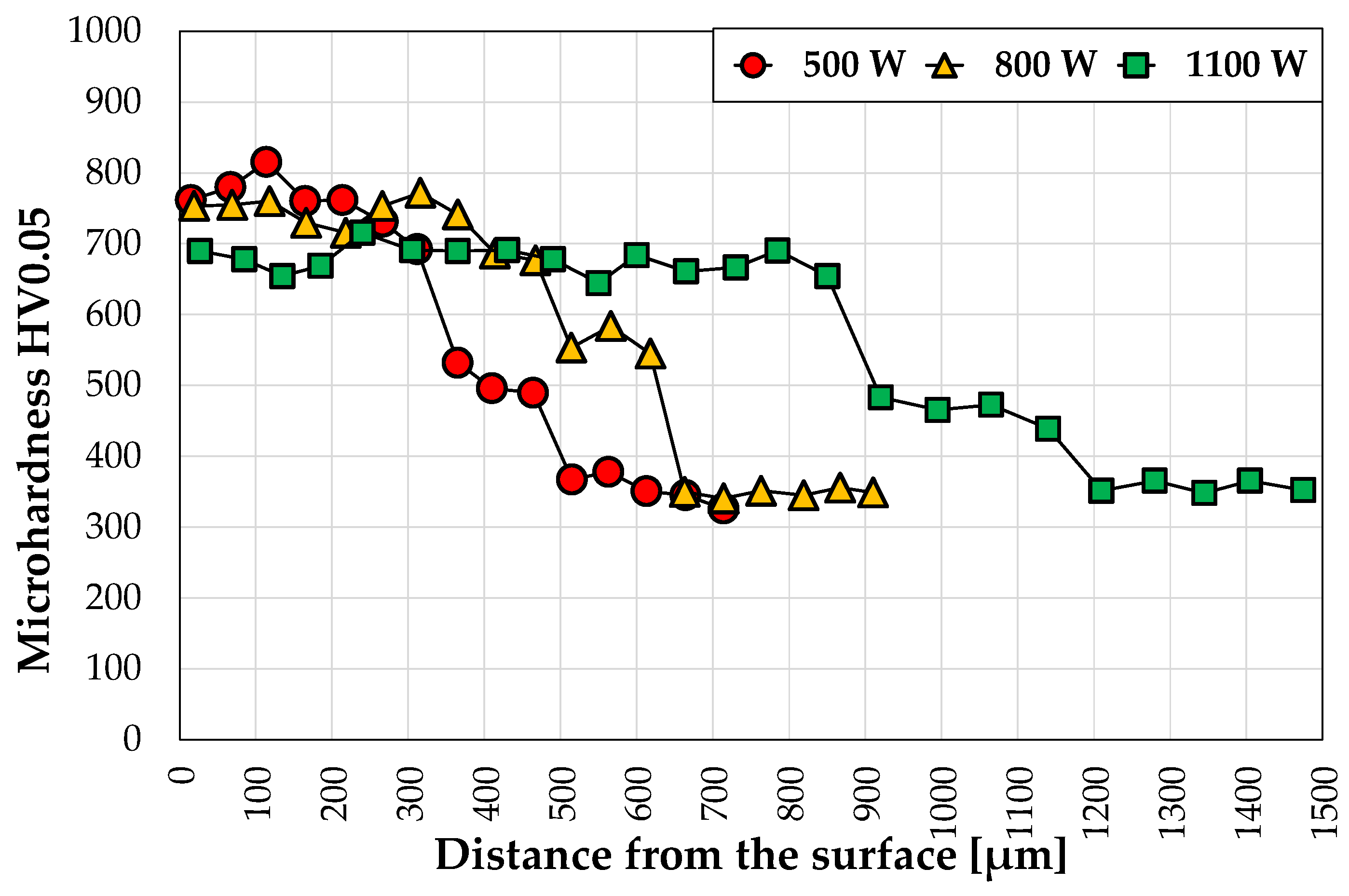

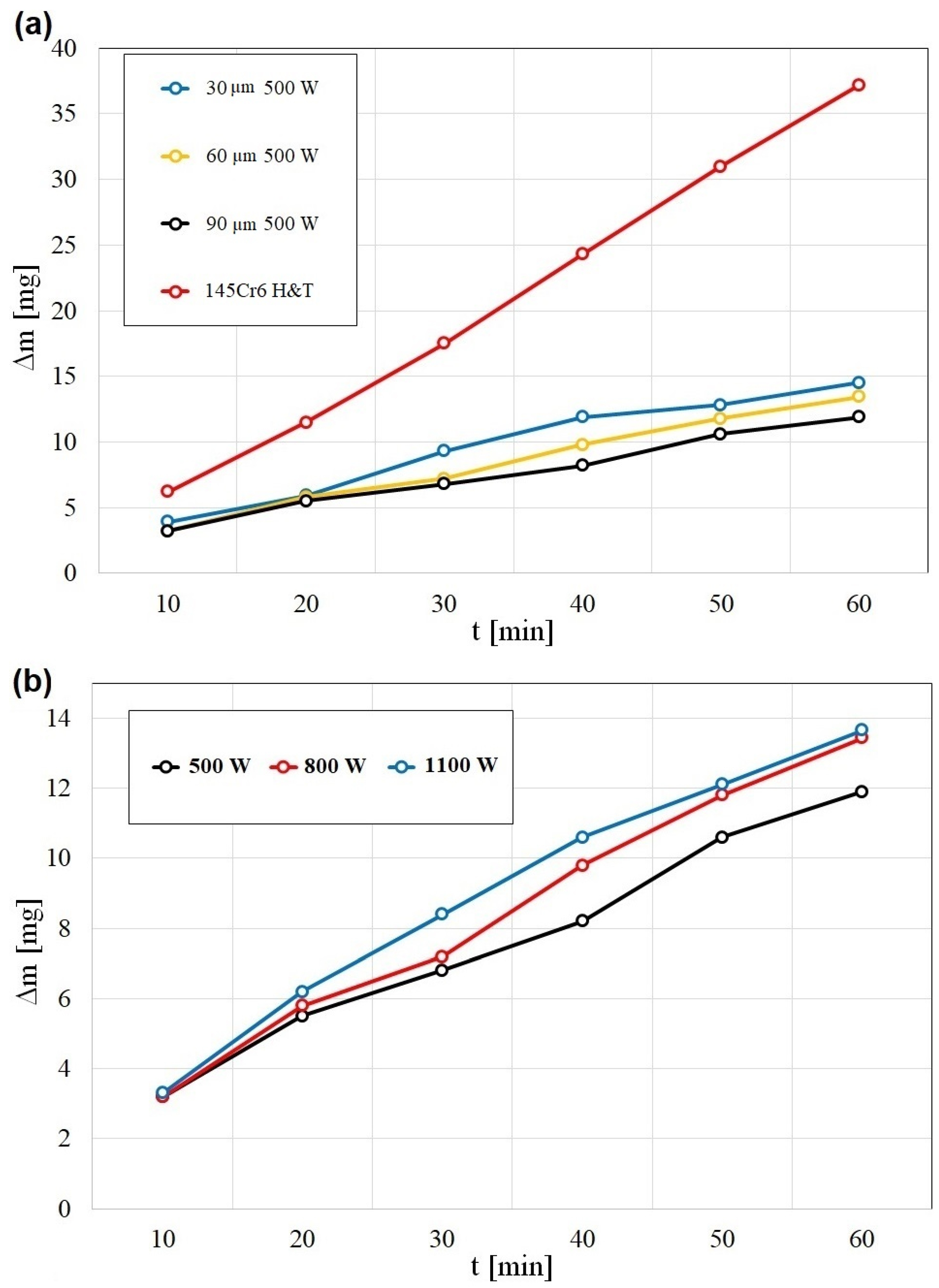

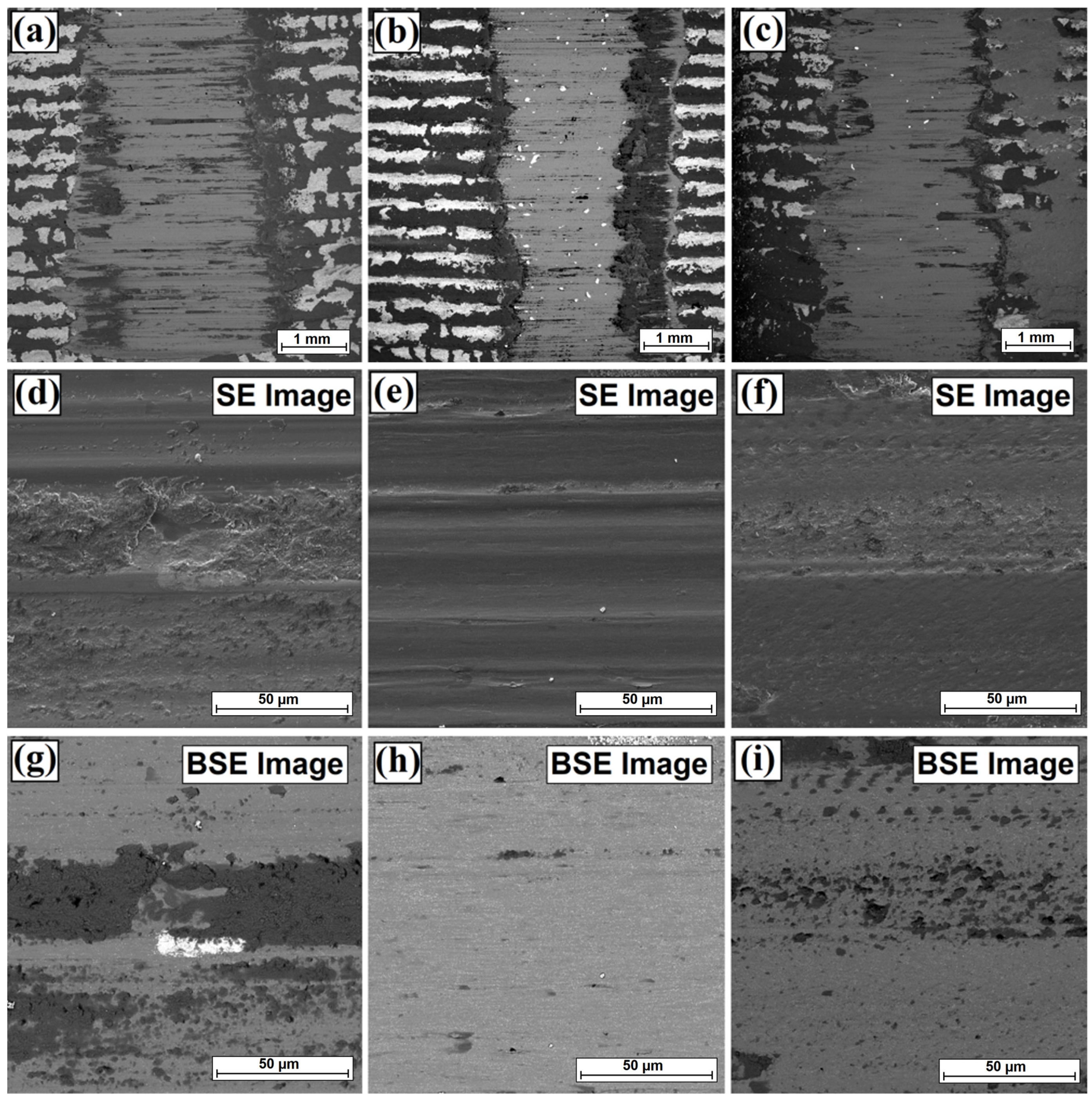
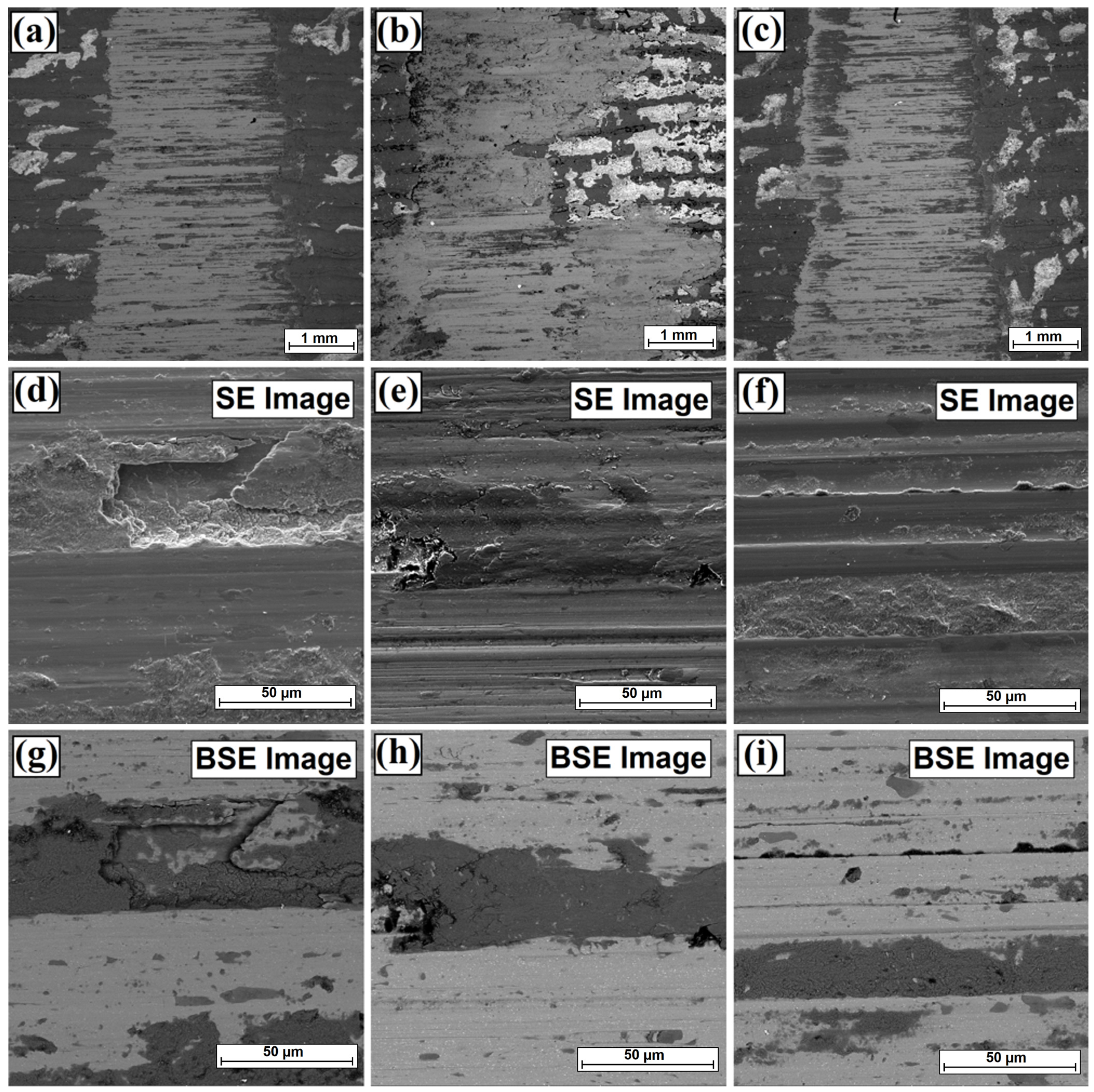
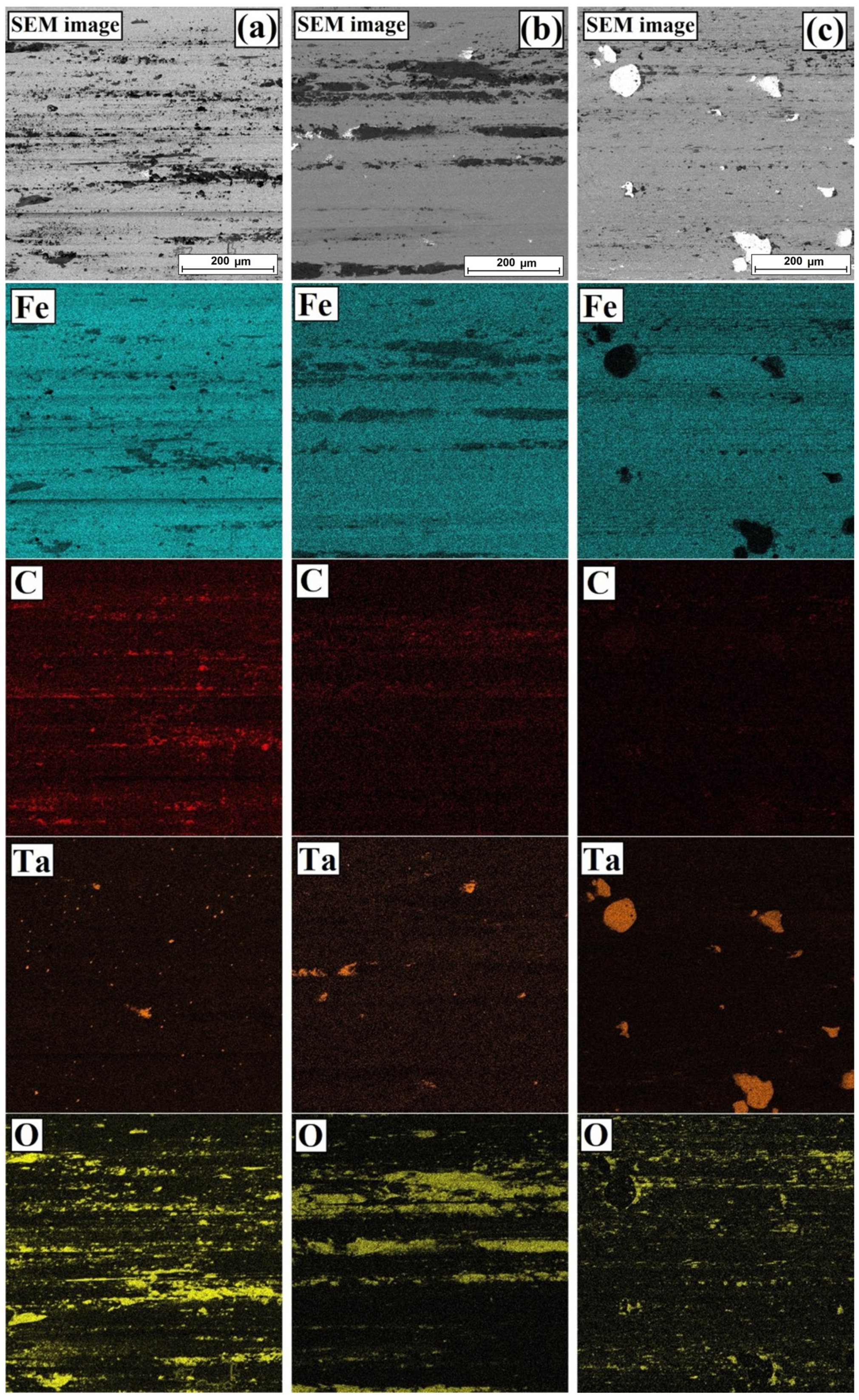
| C | Mn | Si | P | S | Cr | V | Fe |
|---|---|---|---|---|---|---|---|
| 1.35 | 0.60 | 0.30 | 0.02 | 0.02 | 1.45 | 0.20 | Balance |
| Coating Type/Test Zone | No | Fe | Ta | C |
|---|---|---|---|---|
| Figure 5. 500 W 30 µm | 1 | 81.6 | 12.6 | 5.8 |
| 2 | 76.8 | 16.7 | 6.5 | |
| 3 | 86.2 | 7.7 | 6.1 | |
| Figure 5. 500 W 60 µm | 1 | 42.2 | 51.9 | 5.9 |
| 2 | 72.4 | 21.7 | 5.8 | |
| 3 | 79.2 | 14.3 | 6.5 | |
| Figure 5. 500 90 µm | 1 | 22.8 | 71.6 | 5.6 |
| 2 | 64.9 | 30.8 | 4.3 | |
| 3 | 78.4 | 16.7 | 4.8 | |
| Figure 6. 800 W 30 µm | 1 | 83.2 | 12.5 | 4.3 |
| 2 | 78.9 | 15.2 | 5.9 | |
| 3 | 92.5 | 3.5 | 4.1 | |
| Figure 6. 800 W 60 µm | 1 | 75.6 | 17.8 | 6.7 |
| 2 | 75.5 | 18.3 | 6.2 | |
| 3 | 90.1 | 3.9 | 6.0 | |
| Figure 6. 800 W 90 µm | 1 | 67.9 | 24.4 | 7.7 |
| 2 | 77.0 | 16.3 | 6.7 | |
| 3 | 89.0 | 3.8 | 7.3 | |
| Figure 7. 1100 W 30 µm | 1 | 76.6 | 17.5 | 5.9 |
| 2 | 93.5 | 1.4 | 5.1 | |
| 3 | 94.4 | 1.4 | 4.2 | |
| Figure 7. 1100 W 60 µm | 1 | 75.0 | 18.9 | 6.1 |
| 2 | 90.9 | 3.0 | 6.1 | |
| 3 | 91.7 | 2.6 | 5.7 | |
| Figure 7. 1100 W 90 µm | 1 | 71.3 | 19.9 | 8.8 |
| 2 | 91.8 | 2.9 | 5.4 | |
| 3 | 91.9 | 1.9 | 6.2 |
Disclaimer/Publisher’s Note: The statements, opinions and data contained in all publications are solely those of the individual author(s) and contributor(s) and not of MDPI and/or the editor(s). MDPI and/or the editor(s) disclaim responsibility for any injury to people or property resulting from any ideas, methods, instructions or products referred to in the content. |
© 2023 by the authors. Licensee MDPI, Basel, Switzerland. This article is an open access article distributed under the terms and conditions of the Creative Commons Attribution (CC BY) license (https://creativecommons.org/licenses/by/4.0/).
Share and Cite
Bartkowski, D.; Bartkowska, A. Fe/TaC Coatings Produced on 145Cr6 Steel by Laser Alloying—Manufacturing Parameters and Material Characterization. Coatings 2023, 13, 1432. https://doi.org/10.3390/coatings13081432
Bartkowski D, Bartkowska A. Fe/TaC Coatings Produced on 145Cr6 Steel by Laser Alloying—Manufacturing Parameters and Material Characterization. Coatings. 2023; 13(8):1432. https://doi.org/10.3390/coatings13081432
Chicago/Turabian StyleBartkowski, Dariusz, and Aneta Bartkowska. 2023. "Fe/TaC Coatings Produced on 145Cr6 Steel by Laser Alloying—Manufacturing Parameters and Material Characterization" Coatings 13, no. 8: 1432. https://doi.org/10.3390/coatings13081432







